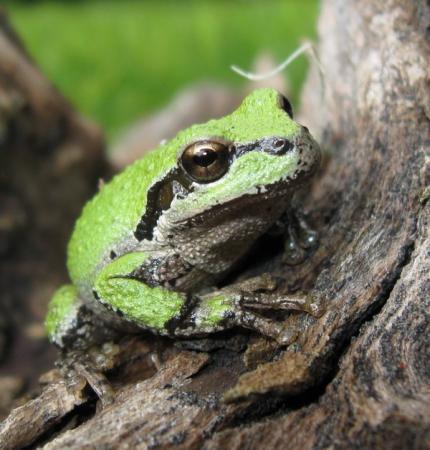
Frogs, along with salamanders and newts, are members of the animal group called amphibians. Amphibians (from the Greek words amphi, meaning "both," and bios or "life") are fittingly named. Frogs start their lives as totally aquatic animals with gills and a pronounced tail fin; this is familiar to many people as the tadpole stage. Over time, legs develop, the tail and gills are absorbed, and the frog becomes a terrestrial, air-breathing animal.
The Pacific treefrog (Pseudacris regilla, Fig. 1) is the smallest but most commonly seen and heard frog in Washington, and for that reason much of this page is devoted to it.
The Pacific treefrog is an adaptable species found from rainforests near sea level, to mountains at 11,000 feet, and on into dry interior areas of Washington where water is available. Adults measure 2 inches in length and vary in color from a bronze brown to a light lime green, and from solid in color to intricate patterns. A sharply defined black mask extends from the tip of its snout to its shoulder.
The "song" or call of the male treefrog, designed to attract females, is a loud, two-part kreck-ek, or a ribbit, often repeated many times. This calling stimulates other males to join in, and large concentrations of these frogs can be heard far away, especially on nights when air temperatures remain above 45 degrees. Male treefrogs call mainly in the evening and at night, although they often call sporadically during the day at the height of the breeding season. A dry-land call made by male treefrogs away from their breeding ponds is a single-note Krr-r-r-ek.
When Hollywood moviemakers wanted frog calls to convey the feeling of nighttime outdoors, they recorded treefrogs. Consequently the "ribbit-ribbit" calls of this species have become the stereotypical frog call, even in areas where treefrogs don't occur.
Facts about Washington treefrogs
Habitat Needs of Adults
- Depending on location, treefrogs move into breeding sites from February (coastal areas) to July. Breeding sites include ponds, swamps, marshes, and roadside ditches—even puddles that dry up during the warm months.
- Outside of the breeding season, adult treefrogs inhabit a variety of habitats, including woodlands, meadows, pastures, and gardens—at times several hundred yards from water. Note: Ponds, swamps, marshes, and similar spots are used only a few weeks or months of the year; treefrogs spend the rest of the year in surrounding areas.
- During dry periods and in arid areas, adult treefrogs are active only at night, spending the day in water or shaded vegetation, a rock or log crevice, rodent burrow, or other protected place.
- Treefrogs secrete a waxy coating from their skin glands that allows them to remain moist and travel far from water.
Food and Feeding Habits
- Toe pads on their front and hind toes enable treefrogs to climb in search of beetles, flies, spiders, ants, and leafhoppers. Adults have been seen and heard up in trees and outside windows two stories high.
- Adult treefrogs catch prey with their long, elastic-like, sticky ended tongues.
- Treefrog tadpoles eat algae, decaying vegetation, and scavenge on dead earthworms, fish, or whatever else is available.
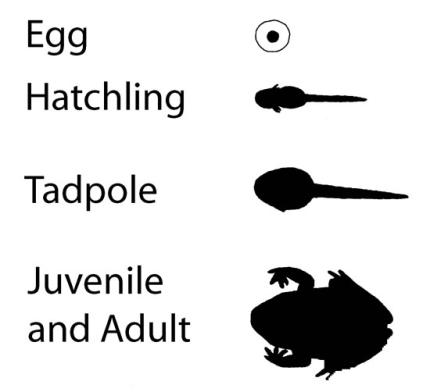
Reproduction and Life Cycle
- Male treefrogs are the first to move into their aquatic breeding areas and soon begin chorusing to attract females. Males chorus while floating at the surface or sitting partially submerged in shallow water.
- Females lay 400 to 750 eggs, which are externally fertilized by the male.
- Individual egg masses contain 10 to 75 eggs, measure 1 to 2 inches across, and are surrounded by a special jelly that swells up on contact with water.
- Egg masses are attached to sticks or grasslike vegetation below the surface, or may be on the bottom in shallow areas. Egg masses often become camouflaged with algae and sediment.
- Eggs hatch more quickly in warmer water, with the time averaging two to three weeks.
- Tiny hatchlings soon turn into tadpoles with short, round bodies and eyes that bulge out at the sides of their heads (Fig. 2).
- In five to six weeks, tadpoles turn into 1/2-inch long, air-breathing juvenile frogs that climb onto land but eventually return, like their parents, to breed in water.
- Treefrog populations are notorious for dramatic year-to-year fluctuations. They may not breed at all if the rainy period of the year is too short, as happens in some droughty years.
Mortality and Longevity
- Treefrog eggs are eaten by caddisfly larvae and fish. Fungus and frost also kills some eggs.
- Treefrog tadpoles are eaten by dragonfly larvae, diving beetles, fish, long-toed salamander larvae, bullfrogs, garter snakes, and birds (herons, ducks, and jays).
- On land and at the water's edge, raccoons, foxes, coyotes, river otters, skunks, snakes, hawks, and owls eat adult treefrogs. Cats, children, lawn mowers, and vehicles all take their toll on adult treefrogs.
- The loss of wetlands and natural ponds eliminates breeding areas; chemicals from pesticides and runoff poison treefrogs and their food.
- Most treefrogs die at the egg or tadpole stage, hence having a life expectancy of only a few weeks. Treefrogs that reach adulthood live an average of two years in the wild.
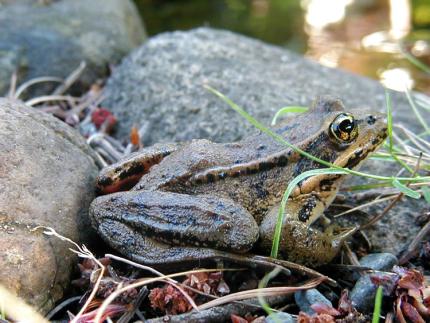
Native Frogs of Washington
In the cooler, more moist areas of Washington, the frogs you are likely to hear or see are the treefrog and red-legged frog; in arid areas the dominant species are the treefrog and the spotted frog. The following are descriptions of these and other less common species:
The red-legged frog (Rana aurora, Fig. 3) is fairly common west of crest of the Cascade Range. It inhabits moist forests near cool ponds, lakes, and slow streams, especially where aquatic vegetation provides cover. During the nonbreeding season this frog may be found several hundred yards or more away from permanent water. It can be as much as 4 inches long and gets its name from the deep wine-red (burgundy) undersides of its legs, thighs, and portions of the belly.
The call is a series of five to seven quiet, low-pitched notes—uh-uh-uh-uh-uh. Males often call from under water and the call is barely audible when made above water.
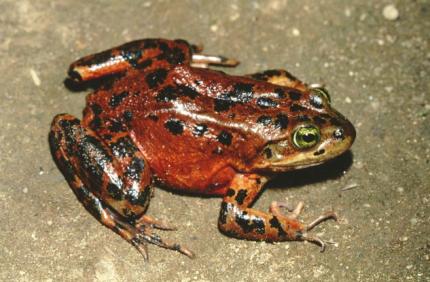
The Columbia spotted frog (Rana luteiventris) occurs east of the Cascade mountains in marshy edges of permanent ponds, lakes, and streams. Adults are 3 inches long and light to dark brown, gray, or olive green, with dark spots on their back, sides, and legs. The undersides of their legs are bright red, salmon, or orange. Their upturned bright-yellow eyes are characteristic of this frog.
It is uncommon to hear this frog call, but it may allow you to observe it closely. Its call is a rapid series of 5 to 30 faint, low-pitched, hollow notes that sound like a distant woodpecker tapping on hard, resonant wood.
The species formerly known as the "spotted frog" has recently been separated into this species and its near relative, the Oregon spotted frog (Rana pretiosa, Fig. 4). The Oregon spotted frog is similar in appearance and occurs in a handful of localities in the Puget Sound lowlands.
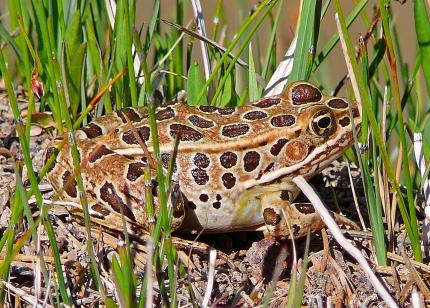
The Cascades frog (Rana cascadae) occupies mountain meadows and moist forests above 1,500 feet. This frog breeds in marshy bogs or ponds, often along the margins of slow-moving mountain-meltwater streams. It is 2-1/2 inches long and olive to brown, usually with black spots on its back and legs. The undersides of the adults' legs are yellow. Its call is a series of low-pitched clucking noises.
The Northern leopard frog (Rana pipiens, Fig. 5) occurs only in a few areas in eastern Washington. Their populations have declined dramatically and they have been wiped out in much of the Pacific Northwest. This frog reaches 4 inches in length and is easily recognized by the large, dark spots with pale borders on its back, sides, and legs. Its call lasts several seconds and consists of a series of low-pitched snorts or grunts that have been compared to the puttering of a small motorboat.
Viewing frogs
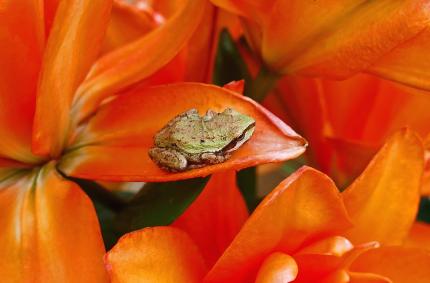
Frogs tend to be more active at lower temperatures than snakes and lizards. As a result, they can be seen in the fall and early spring when most reptiles are in a hibernation-like state. On warm, rainy nights during spring and fall, search trails, roads, and other openings for adult frogs (and toads) on the way to or from breeding sites.
Examine ponds, swamps, marshes, and other bodies of fresh water from February through August for breeding adults, eggs, tadpoles, or juveniles. Slowly and quietly approach the area, using binoculars to detect animals visible along the waterline or the characteristic dual eye-bumps of frogs on the water surface.
Adult and juvenile frogs are usually found at the surface, at the water's edge, or in moist vegetation along the shore. Recently metamorphosed juveniles often are found under objects around the edges of the water. Occasionally, after rains, they can be found moving into upland areas near breeding sites in large numbers. When examining areas under rocks, wood, and other material, always carefully replace the covering in its original position.
Breeding sites for frogs are often located in the warmest water locations, including water within or adjacent to thin-stemmed emergent plants such as rushes, sedges, and aquatic grasses. Tadpoles are found near large pieces of wood or rocks that store heat. Likewise, they tend to cluster in the warmest water they can find—often in shallow areas with lots of sun exposure.
Most frogs start to call about half an hour after sunset. Calling also occurs during dark and rainy days. When listening to identify a frog species, remember that the calls are generally slower in colder temperatures, and faster when it is warm.
Handling frogs can be hazardous to their health and needs to be done carefully—or not at all. Their permeable skin could absorb harmful chemicals from your hands, such as lotion or bug repellent. Amphibians can also die from moisture loss, known as desiccation. Handling them increases this risk.
Tips for Frog Watchers
Here are some hints for frog watchers heading into the field:
- If you frog-watch alone, let someone know where you are going and when you plan to be back.
- Don't wade out into ponds or marshes—you will scare the frogs, and there is the risk that you may slip and fall into the water.
- Keep a close eye on children.
- Have a change of clothes just in case you get wet.
- Watch for stinging insects. If you have an allergy to stings, be absolutely sure you have your sting kit with you.
- Use polarized sunglasses and binoculars for better viewing.
- If you are frog-watching on private land, ask permission from the landowner.
- Make sure dogs are leashed—better still, leave them at home.
Attracting & maintaining amphibians on your property
Because their total habitat requirements extend from water onto the land, it is difficult to maintain wild frogs and other amphibians in most yards. If your yard is surrounded by concrete and highly maintained landscapes, chances are slim that these interesting animals will visit.
The chances of hosting frogs and other amphibians increase if your property adjoins an undeveloped area, such as a greenbelt or other wild area, or if it is next to a wetland, stormwater retention pond, or other freshwater area. Your chances further increase if you establish and maintain a natural landscape. Treefrogs are very good at colonizing new areas.
To attract and maintain amphibians on your property:
Protect existing natural areas to the greatest extent possible. Protect woodlands, wetlands, meadows, stream corridors, shorelines, and other wildlife habitat on your property; encourage your friends and neighbors to do the same. Support public acquisition of greenbelts, remnant forests, and other wild areas in your community. Write to legislators and attend public meetings when regulations are being considered.
Protect buffer areas next to streams, lakes, or ponds. The vegetated buffers surrounding these areas protect the ecological functions and value of the breeding habitat, and provide needed upland habitat for amphibians.
Wherever possible, protect migration paths between uplands and breeding sites. If amphibian migrations to breeding sites cross neighborhood roads, try placing signs to inform local drivers of this crossing. If a new road is to be constructed in migration areas, work for installation of amphibian crossing structures, such as small tunnels under the roadway. Amphibian movements can also be guided by means of drift fences and large logs. If you have an area on your property that is used by migrating amphibians, leave the area as natural as possible.
Leave a portion of your grass unmowed, especially in areas that adjoin a wet area, forest edge, or any other distinct habitat, as well as any area that is being used by migrating amphibians. If you must mow in these areas, mow at slower speeds and be ready to step on the clutch or brake. Set the mower blades as high as possible, or use a weed-whacker and leave grass 6 inches high.
Regularly mow any areas you want to keep as lawn to prevent longer grass developing where frogs may hide. Mowing in hot, dry weather will minimize the chances of finding amphibians, and making some disturbances before mowing may encourage frogs to hop out of the way. Don't mow or weed-whack when many amphibians are seen breeding migrations or juvenile dispersal periods.
Preserve leaf litter under trees and shrubs. Such material provides cover and moisture; it also attracts organisms that amphibians eat.
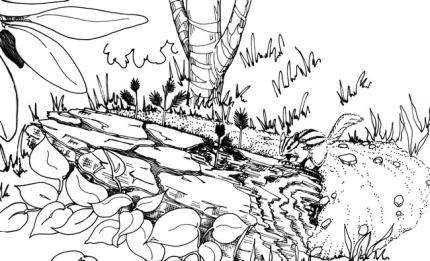
Retain stumps, logs, rootwads, rock piles, and other debris that provides a cool, moist habitat for amphibians. Such habitat features provide much needed cover. All these can be strategically located as "stepping stones" across exposed areas, or to bridge gaps between breeding ponds and woods. To be effective in exposed areas, keep the structures within 15 feet of each other.
With permission from landowners, you could salvage these materials from cleared or logged areas and install them in your landscape, preferably away from busy roads (Fig. 6).
Consider building a pond. Treefrogs will breed in almost any type or size of pond. If your pond is aimed at amphibians in general, however, it is critical not to stock fish, given the problems with predation and the increased nutrient load that may result. For fish lovers, one option is to build a separate pond specifically for fish.
Fence large ponds to prevent access by livestock, to protect the water, and to allow a more diverse plant community to grow, providing cover for amphibians and their food source.
Avoid using pesticides and herbicides. Amphibians have highly permeable skin that can absorb toxic chemicals from your lawn, and they can be poisoned directly or indirectly through their food, such as slugs and snails. Moss-killers and roof treatment chemicals can also be toxic, and often such runoff is directly channeled into wetlands via pipes or sewer outflows.
Collecting and Releasing Frogs
If frogs are not present in your yard, there is probably a good reason. Generally, the conditions surrounding your property are not right for them. Attempting to move a frog into your yard when conditions are not appropriate for it will probably result in killing the animal.
Another reason for not relocating these animals is their well-developed homing instinct. Many will immediately leave an unfamiliar area and, drawn by instinct, try to return to their place of origin. This usually results in their being killed on roads or by predators they are exposed to on their journey.
If you enhance your yard for frogs, and if they occur naturally in your general vicinity, sooner or later you will probably enjoy seeing them on your property. Meanwhile, work with the wildlife species that do visit your property and help preserve nearby wild areas.
Many frog species are popular as pets. Unfortunately, owners often tire of them and release them (illegally) to fend for themselves (see Legal Status). Many of the pet-store species cannot survive our climate and will die if released. On the other hand, some species, such as the bullfrog often do survive. They may introduce new diseases or compete with native frogs and other species.
Preventing conflicts
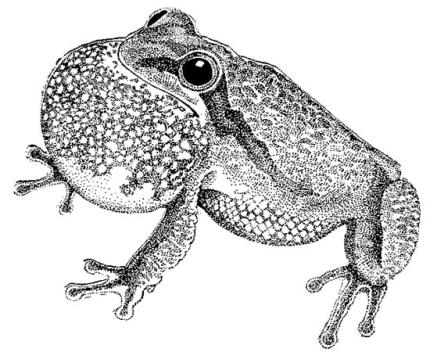
The noise one or more treefrogs may be annoying to some people, particularly light sleepers (Fig. 7).
If for some reason the presence of frogs cannot be tolerated, or to exclude them from an area where they might be injured or killed, install a barrier. Aluminum hardware cloth, or another type of rust-resistant material, can be used to surround a pump or other mechanical device within the pond to eliminate mortality. This will need to be maintained regularly. Note: a fence will not keep treefrogs out.
To prevent frogs from breeding in a small pond, keep it empty, or keep a waterfall or other source of turbulence in place to discourage frogs from using it during the breeding season. Egg masses can also be removed, as can adults. Or just add fish! (See below for information on managing bullfrogs.)
Repellents and scare devices do not work on frogs. No poisons should ever be added to the water to keep these animals out.
Bullfrogs
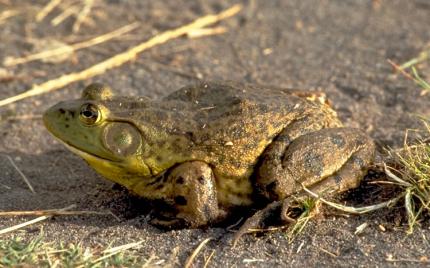
The bullfrog (Rana catesbeiana, Fig. 8) is an invasive species that has successfully spread throughout the low elevations of Washington. Large populations of this species are believed to have contributed both directly and indirectly to the drastic decline of native amphibians and reptiles.
The bullfrog is the largest true frog in North America. It can measure 8 inches in length, leap up to 3 feet, and live nearly ten years. Bullfrogs are occasionally seen crossing roads, even during periods of dry weather, and may travel overland up to a mile. This movement allows them to expand their range from the source where they were introduced. The large number of eggs in each egg mass laid by the females allows bullfrogs to quickly establish themselves within a new territory.
Bullfrogs get their name from the baROOM mating call made by the males. Juveniles and adults of both sexes emit a squeak just prior to jumping into water when avoiding an intruder.
The original native range of bullfrogs was the eastern United States, but they have been introduced to most of western North America, from southern British Columbia to Baja California. Bullfrogs were first introduced into Washington during the Great Depression (early 1930s) to provide opportunities for frog hunting, food (i.e., frog legs), and stock for frog farms, enterprises that rarely succeeded.
Bullfrogs thrive in the warm waters of natural and man-made ponds, marshes, sloughs, reservoirs, and sluggish irrigation ditches and streams. Bullfrogs tolerate polluted and muddy waters better than do most native frogs, and may be found within cities in wetlands, reservoirs, and stormwater ponds.
In their northern range and in cooler climates, bullfrogs persist only in year-round bodies of water because they require two years to develop from eggs into adult frogs. In their southern range and in warmer areas, they have been known to fully metamorphose in one year and colonize semi-permanent and seasonal ponds. (Such cases have been documented by biologists in Oregon.)
Bullfrogs breed only after the nights warm up and reach the high 60s and 70s (Fahrenheit), generally June and July here in Washington.
Adult bullfrogs and tadpoles overwinter in mud on the bottom of ponds and other bodies of water. They hibernate by burying themselves in surface mud or by digging cave like holes underwater. Adults also hibernate on land near ponds where they bury themselves within the soil. Their body temperature may drop virtually to the freezing point, and their hearts slow so drastically they seem to atop altogether. But they continue to absorb oxygen through their moist skin, and when their surroundings thaw, they emerge into the spring sunshine to resume their business of catching insects and other prey.
Adult bullfrogs usually are "sit and wait" predators that readily attack almost any live animal smaller than themselves—insects, frogs, tadpoles, fish, small snakes, turtle hatchlings, newts, salamanders, bats, hummingbirds, and ducklings. Bullfrogs use their sticky tongues to subdue prey, but that's not their only method of securing food. Large frogs are more likely to lunge at their targets. Once they get a grip with their wide, sturdy jaws, they use their front feet to shove the items down their gullets.
Garter snakes regularly catch and eat bullfrog tadpoles and adults. Painted turtles also eat some in late summer, when adult and developing bullfrogs become sluggish for some unknown reason. Large bullfrogs also capture smaller ones and eat them.
The relatively unpalatable nature of bullfrog tadpoles may give them the ability to coexist with many otherwise potential fish predators. Bullfrog eggs can be eaten by many predators (leeches, salamanders, fish) with no obvious detrimental effects to the predator.
Under no circumstances should you take or purchase bullfrog tadpoles for your home pond, transfer wild-caught bullfrogs, or in any way encourage them to expand their range. If you are adding plants or water to a small pond, make sure you are not also adding bullfrog eggs or tadpoles.
Bullfrog Identification
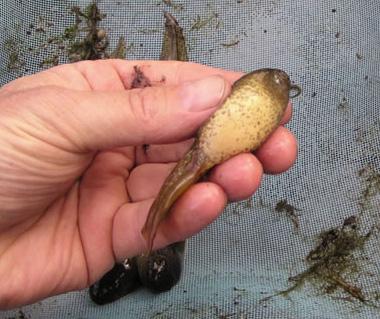
Each female bullfrog creates one thin-jelly egg mass that may contain 6,000 to 20,000 very small eggs, which are black on top and white underneath. Egg masses are generally found in water that is less than 2 feet deep in mid to late summer. The eggs start out as a round, basketball-size mass (below or near the surface) that then rises, flattens out, and forms a 2- to 4-inch gelatinous mass 2 feet in diameter. The egg mass floats on the surface of the water or rests on the bottom within sparse vegetation. The mass remains attached to deep vegetation in some places and is often covered in algae.
The tadpoles are dark green with black dots, orange or bronze eyes, and opaque yellow underbellies (Fig. 9). A two-year-old tadpole may be 4 to 6 inches long.
The juveniles are green to brown with a peppering of tiny black spots, and have orange or bronze eyes. A fold of skin extends from the eye around the eardrum.
Adult bullfrogs have thickset bodies, large, exposed eardrums, and are green, tan, or dark brown above (with dark spots). Male bullfrogs have a yellow throat. The eardrums on males are larger than the eyes, while the female's eardrums are the same size as the eyes. The eyes of both sexes are gold.
Managing Bullfrogs
The removal of bullfrogs is unlikely to be a viable management option in most wild or semi-wild situations owing to the difficulty of removing all bullfrog eggs, tadpoles, and adults, and preventing surrounding bullfrogs from invading the water body. However, in a small wetland or pond it may be possible to eliminate the local bullfrog population by visiting the pond daily through the breeding season and removing all eggs, tadpoles, and adults. Long-term success depends on closely monitoring the pond to prevent other bullfrogs from breeding.
Bullfrog control techniques should be limited to those that cause the least harm to native amphibians. At least one person should be able to identify all stages of native amphibians when attempting to manage bullfrog populations. Foot traffic in areas where many juvenile toads, red-legged frogs, or other species are about should be minimized.
Adult bullfrogs are difficult to gig or catch in nets because they are very wary and leap for the water at first approach. However, when they stare at a bright light at night, they seem unable to see a hand, net, or frog gig reaching out to grab them. Wear a headlamp to keep your hands free, or have someone next to you spot the bullfrogs using a powerful flashlight. Some people have found capturing adult bullfrogs in turtle hoop-nets to be a useful management technique.
Because adult bullfrogs are less active in cooler water, usually March and April are the best months for catching them.
Bullfrog tadpoles are equally difficult to catch because they quickly swim to deeper water to avoid capture. However, capture is made easier if the water body in which the tadpoles (and adults) live and breed is lowered with a pump or by another means to make them more accessible. Tadpoles are best captured using a long-handled dip net (not a fish net).
Tadpole collection should be done when non-target species (especially native amphibians) are unlikely to be caught. For instance, in early September, when native frogs and salamanders occupying the site have turned into their juvenile stage and the only tadpoles left are bullfrog tadpoles.
Bullfrog eggs should be carefully collected in a large dip net or a 5-gallon bucket to avoid breaking up the egg masses. Clipping of vegetation may be necessary to dislodge the egg masses.
Euthanasia of adult bullfrogs and tadpoles can be accomplished by a stunning blow to the head, followed by decapitation. Egg masses can be left on site a distance away from the water body to be eaten by a bird, other animal, or simply to dry out and desiccate.
Since bullfrogs generally require two years to develop, it may be possible to rid an area of these animals by draining the water body they inhabit. This assumes that there isn't another nearby water body that can serve as temporary harborage. (Where ponds have dried up naturally, adult bullfrogs have been known to seek refuge in nearby wells, springs, animal burrows, and crevices in the ground.)
Additional information
Legal Status
The Northern leopard frog and Oregon spotted frog are state endangered species (WAC 220-610-010) and cannot be hunted or trapped. All other species of frogs are unclassified and can be controlled without a permit.
The bullfrog is classified as a prohibited aquatic animal species (WAC 220-12-090). These species are considered by the commission to have a high risk of becoming an invasive species and may not be possessed, imported, purchased, sold, propagated, transported, or released into state waters except as provided in RCW 77.15.253, which allows for the transport of prohibited aquatic animal species to the department, or to another destination designated by the director, in a manner designated by the director, for the purposes of identifying a species or reporting the presence of a species. The unlawful release of a prohibited aquatic animal species is a gross misdemeanor. A second violation within five years is a class C felony.
Bullfrogs can be taken by angling, hand dip netting, spearing (gigging), or with bow and arrow only (WAC 220-416-120). No license is required to hunt bullfrogs, there are no bag limits, and the season is open year round (WAC 220-12-090). Bullfrogs must be dispatched on site. Physical euthanasia is recommended.
It is unlawful to import into the state, hold, possess, offer for sale, sell, or release all frog species into the wild without the proper license to do so (WAC 220-450-030).
Books
- Corkran, Charlotte C., and Chris Thoms. Amphibians of Oregon, Washington, and British Columbia: A Field Identification Guide. Vancouver, BC, and Redmond, WA: Lone Pine, 1996.
- Kozloff, Eugene N. Plants and Animals of the Pacific Northwest. Seattle: University of Washington Press, 1976.
- Leonard, William P., et al. Amphibians of Washington and Oregon. Seattle: Seattle Audubon Society, 1993.
- Link, Russell. Landscaping for Wildlife in the Pacific Northwest. Seattle: University of Washington Press and the Washington Department of Fish and Wildlife, 1999.
- Matson, Tim. Earth Ponds: The Country Pond Maker's Guide to Building, Maintenance, and Restoration. Woodstock, VT: Countryman Press, 1991.
- Nash, Helen. The Pond Doctor: Planning and Maintaining a Healthy Water Garden. New York: Sterling, 1994.
- Nussbaum, Ronald A., et al. Amphibians and Reptiles of the Pacific Northwest. Moscow, ID: University of Idaho Press, 1983.
- Storm, R. M., and W. P. Leonard, eds. Reptiles of Washington and Oregon. Seattle: Seattle Audubon Society, 1995.